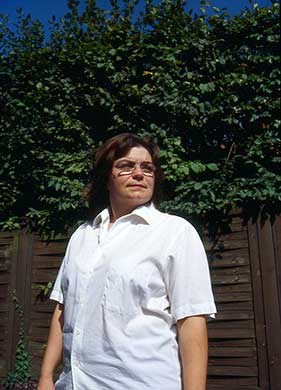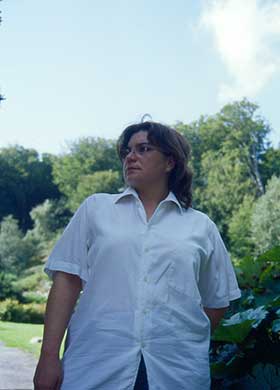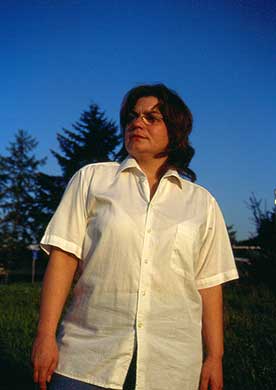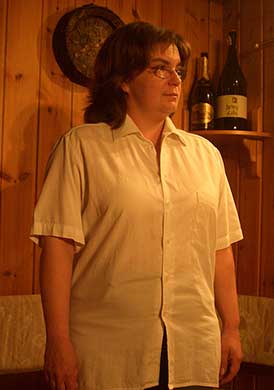You are here: Nature Science Photography – Lightness and color – The role of lighting quality
As far as color reproduction is concerned, the analog color film tuned to average daylight with a color temperature of 5,600 to 6,000 Kelvin naturally lacks the downstream steps of our neural processing. Unlike our visual apparatus, it can only register the wavelength pattern reflected from the objects. If a specific range dominates in this reflected spectrum, it leads to a disproportionate exposure of the corresponding layer, resulting in a color cast. Ansel Adams has commented nicely on this connection: „The emulsions of most color transparency films are formulated to produce a ‚realistic‘-looking photo only if the film is exposed in daylight at midday or with an electronic flash.“ (19) – No German tax official can fit many more exceptions into one sentence! But who knows, maybe the film is even a more neutral observer of the two of us! Something else is striking about the sentence. It speaks of „color transparency film“, i.e., slide material. Only with this film do we need to adjust the light temperature during the exposure process, as there is no further copying process after the development stage. On the other hand, enlargement of negative film allows for the removal of the color cast.
If, for example, the photographer wants to adjust a picture taken under halogen light (31 decamired) to his perception, he must therefore take corrective action. Either he uses an artificial light film set to the light temperature of 3,200 Kelvin or he counteracts the color cast with a conversion filter. The correct filter is calculated from the difference between the existing and the necessary color temperature according to the following rule of thumb:
Decamired value (filter) = Decamired value (light) - Decamired value (film).
In our case, the calculation looks like this:
Dekamired value (filter) = 31 -18 = 13
So we need a correction of +13 decamired. The positive value specifies a reddish filter. If it were negative, it would have to be a blue filter. The type designation of conversion filters is a bit misleading because, to this day, the Kodak Wratten designations and the Dekamired classifications are used side by side. The arbitrary Wratten designations consist of a one- or two-digit number, sometimes followed by a letter (e.g., 81 A). They can be traced back to Charles Wratten, who developed the system in the early 20th century. Eastman-Kodak later took over his company, leading to the widespread use of the designations. They are contrasted by the conversion filters of the types „KR“ (correction red) and „KB“ (correction blue), whose strength is specified completely systematically in Dekamired values. Therefore, a KR 12 is a red conversion filter with a Dekamired value of 12.
Let’s return to our initial calculation. Since there is no correction filter in strength 13, Dekamired, we use KB 12 and add KB 1.5 to it if necessary because the filters are additive with respect to their Dekamired value. Conversely, only a fluorescence filter for the corresponding light color (FL-D for daylight tubes or FL-W for warm-tone tubes) can compensate for the green cast of neon tubes. Provided that the exposure is made with a digital camera, you can circumvent the described fairness with a manual white balance.
However, natural lighting can also pose significant challenges when shooting daylight film. This is due to the fact that sunlight, at its „calibration temperature“ of 5,600 to 6,000 Kelvin, only occurs in the morning between 09:00 and 11:00 and in the afternoon between 13:00 and 15:00 in the normal locations of Central Europe during the summer months. If the light is refracted by a light cloud cover, the indicated periods are extended by about 30 minutes each. In the winter half-year, when the sun does not rise as high, the range shifts to the time between 11:00 and 13:00. Before 9:00 and after 15:00, on the other hand, the light only has a color temperature of around 4,800 K and is accordingly slightly red in excess. To counteract this, use a KB 3 filter or Kodak-Wratten 82 C. The morning and evening red shows an even stronger red tendency at only 4,300 K and requires correction with a KB 6 filter or Kodak-Wratten 80 D. Under an overcast or hazy sky, on the other hand, the light temperature rises to 6,000 K to 8,000 K and promotes a corresponding blue cast. We counteract this with a KR 3 filter (Kodak-Wratten 81 C) or KR 6 filter (Kodak-Wratten 81 E, 81 F). With increasing height of the recording position above the middle altitudes, the short-wave blue light component scattered at the air molecules has a greater effect and drives the light temperature up to 12,000 K and more. This also produces a blue cast that must be corrected with a reddish KR 6 filter or KR 9 filter (Kodak-Wratten 81E, 81F, 85 C). This tendency is observed even in areas far from industrial plants in large cities with very pure air. Black and white films, by the way, do not need any adaptation of the shooting light to their sensitization. The filters used in this area just ensure the faithful reproduction of colors. Without them, the image may reproduce two different colors in grayscales of the same brightness, rendering them indistinguishable. The following overview indicates the correct filters for various frequently occurring lighting situations.
| Film type | Illumination | Filter (filter factor) Kodak-Wratten |
| Daylyight film | Direct sunlight from clear blue sky, 12.000-15.000 K | KR 12 (2) 85 or KR 15 (2,3) 85 B |
Daylight film | Sunlight from clear blue sky, but subject in shadow, 10.000 – 12.000 K | KR 9 (1.8) 85 C |
Daylight film | Fog, slightly to heavily overcast, 8.000 K | KR 6 (1.4) 81 E, 81 F |
Daylight film | Completely overcast sky, 6.700 – 7.000 K | KR 3 (1.2) 81 C |
Daylight film | Sunlight from clear blue sky, 6.000 – 6.500 K | KR 1.5 (1.1) 1 A |
Daylight film | Flash light exposure, 6.000 K | None required |
Daylight film | Sunlight at midday, blue sky, few white clouds, 5.700 – 5.900 K | None required |
Daylight film | Sunlight through light haze, 5.700 – 5.900 K | KB 1.5 (1.1) 82 |
Daylight film | Morning and afternoon sun, Sun position 30°, 5.000 – 5.500 | KB 2 (1,2) 82 A |
Daylight film | Industrial smog in sunny weather, Morning and evening sun, strong haze 5.000 K | KB 3 (1,2) 82 C |
Daylight film | Strong red-orange morning and evening sun, Moonlight 4.100 K | KB 6 (1.5) 80 D |
Daylight film | Halogen lamp, low sun shortly before sunset or sunset or shortly after sunrise, 3400-3500 K | KB 12 (2) 80 B |
Daylight film | Incandescent lamp 60/100 watt, 2.600-2.700 K | KB 20 (2.7) |
Artificial light film | Clear blue sky 10.000 K | KR 12 (2) 85 |
Artificial light film | Lightly to heavily overcast 8.000 K | KR 12 (2) 85 |
Artificial light film | Sun position 30° 5.500 K | KR 12 (2) 85 |
Artificial light film | Heavy haze 5.000 K | KR 6 (1.4) 81 E, 81 F |
Artificial light film | Photo lamp 3.200 K | None required |
Artificial light film | Incandescent lamp 60/100 Watt 2.600-2.700 K | KB 6 (1.5) 80 D |
These are all approximate values. The exact color temperature depends on many variables, and only the use of a measuring device or the exposure of several images with and without filters can give certainty regarding a color cast. However, exercise caution: One often perceives the color cast of an image only through direct comparison with another, filtered image. Taken on their own, most images with only a slight color cast look okay. Again, it’s crucial to capture a series of images, both with and without filters, and, unless it’s a strict subject shot, select the one that ultimately produces the best overall effect. Often, this will be the image that tends toward a slightly warmer color scheme.




Next Digital temperature correction
Main Lightness and Color
Previous Light also has a temperature
If you found this post useful and want to support the continuation of my writing without intrusive advertising, please consider supporting. Your assistance goes towards helping make the content on this website even better. If you’d like to make a one-time ‘tip’ and buy me a coffee, I have a Ko-Fi page. Your support means a lot. Thank you!


 Since I started my first website in the year 2000, I’ve written and published ten books in the German language about photographing the amazing natural wonders of the American West, the details of our visual perception and its photography-related counterparts, and tried to shed some light on the immaterial concepts of quantum and chaos. Now all this material becomes freely accessible on this dedicated English website. I hope many of you find answers and inspiration there. My books are on
Since I started my first website in the year 2000, I’ve written and published ten books in the German language about photographing the amazing natural wonders of the American West, the details of our visual perception and its photography-related counterparts, and tried to shed some light on the immaterial concepts of quantum and chaos. Now all this material becomes freely accessible on this dedicated English website. I hope many of you find answers and inspiration there. My books are on